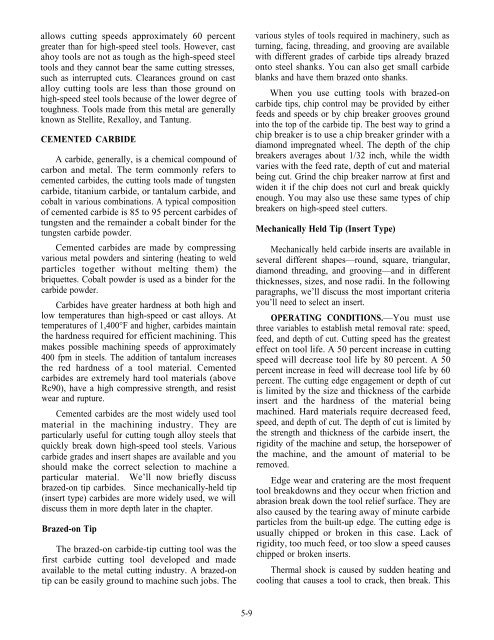Create successful ePaper yourself
Turn your PDF publications into a flip-book with our unique Google optimized e-Paper software.
allows cutting speeds approximately 60 percent<br />
greater than for high-speed steel tools. However, cast<br />
ahoy tools are not as tough as the high-speed steel<br />
tools and they cannot bear the same cutting stresses,<br />
such as interrupted cuts. Clearances ground on cast<br />
alloy cutting tools are less than those ground on<br />
high-speed steel tools because of the lower degree of<br />
toughness. Tools made from this metal are generally<br />
known as Stellite, Rexalloy, and Tantung.<br />
CEMENTED CARBIDE<br />
A carbide, generally, is a chemical compound of<br />
carbon and metal. The term commonly refers to<br />
cemented carbides, the cutting tools made of tungsten<br />
carbide, titanium carbide, or tantalum carbide, and<br />
cobalt in various combinations. A typical composition<br />
of cemented carbide is 85 to 95 percent carbides of<br />
tungsten and the remainder a cobalt binder for the<br />
tungsten carbide powder.<br />
Cemented carbides are made by compressing<br />
various metal powders and sintering (heating to weld<br />
particles together without melting them) the<br />
briquettes. Cobalt powder is used as a binder for the<br />
carbide powder.<br />
Carbides have greater hardness at both high and<br />
low temperatures than high-speed or cast alloys. At<br />
temperatures of 1,400°F and higher, carbides maintain<br />
the hardness required for efficient machining. This<br />
makes possible machining speeds of approximately<br />
400 fpm in steels. The addition of tantalum increases<br />
the red hardness of a tool material. Cemented<br />
carbides are extremely hard tool materials (above<br />
Rc90), have a high compressive strength, and resist<br />
wear and rupture.<br />
Cemented carbides are the most widely used tool<br />
material in the machining industry. They are<br />
particularly useful for cutting tough alloy steels that<br />
quickly break down high-speed tool steels. Various<br />
carbide grades and insert shapes are available and you<br />
should make the correct selection to machine a<br />
particular material. We’ll now briefly discuss<br />
brazed-on tip carbides. Since mechanically-held tip<br />
(insert type) carbides are more widely used, we will<br />
discuss them in more depth later in the chapter.<br />
Brazed-on Tip<br />
The brazed-on carbide-tip cutting tool was the<br />
first carbide cutting tool developed and made<br />
available to the metal cutting industry. A brazed-on<br />
tip can be easily ground to machine such jobs. The<br />
5-9<br />
various styles of tools required in machinery, such as<br />
turning, facing, threading, and grooving are available<br />
with different grades of carbide tips already brazed<br />
onto steel shanks. You can also get small carbide<br />
blanks and have them brazed onto shanks.<br />
When you use cutting tools with brazed-on<br />
carbide tips, chip control may be provided by either<br />
feeds and speeds or by chip breaker grooves ground<br />
into the top of the carbide tip. The best way to grind a<br />
chip breaker is to use a chip breaker grinder with a<br />
diamond impregnated wheel. The depth of the chip<br />
breakers averages about 1/32 inch, while the width<br />
varies with the feed rate, depth of cut and material<br />
being cut. Grind the chip breaker narrow at first and<br />
widen it if the chip does not curl and break quickly<br />
enough. You may also use these same types of chip<br />
breakers on high-speed steel cutters.<br />
Mechanically Held Tip (Insert Type)<br />
Mechanically held carbide inserts are available in<br />
several different shapes—round, square, triangular,<br />
diamond threading, and grooving—and in different<br />
thicknesses, sizes, and nose radii. In the following<br />
paragraphs, we’ll discuss the most important criteria<br />
you’ll need to select an insert.<br />
OPERATING CONDITIONS.—You must use<br />
three variables to establish metal removal rate: speed,<br />
feed, and depth of cut. Cutting speed has the greatest<br />
effect on tool life. A 50 percent increase in cutting<br />
speed will decrease tool life by 80 percent. A 50<br />
percent increase in feed will decrease tool life by 60<br />
percent. The cutting edge engagement or depth of cut<br />
is limited by the size and thickness of the carbide<br />
insert and the hardness of the material being<br />
machined. Hard materials require decreased feed,<br />
speed, and depth of cut. The depth of cut is limited by<br />
the strength and thickness of the carbide insert, the<br />
rigidity of the machine and setup, the horsepower of<br />
the machine, and the amount of material to be<br />
removed.<br />
Edge wear and cratering are the most frequent<br />
tool breakdowns and they occur when friction and<br />
abrasion break down the tool relief surface. They are<br />
also caused by the tearing away of minute carbide<br />
particles from the built-up edge. The cutting edge is<br />
usually chipped or broken in this case. Lack of<br />
rigidity, too much feed, or too slow a speed causes<br />
chipped or broken inserts.<br />
Thermal shock is caused by sudden heating and<br />
cooling that causes a tool to crack, then break. This
















